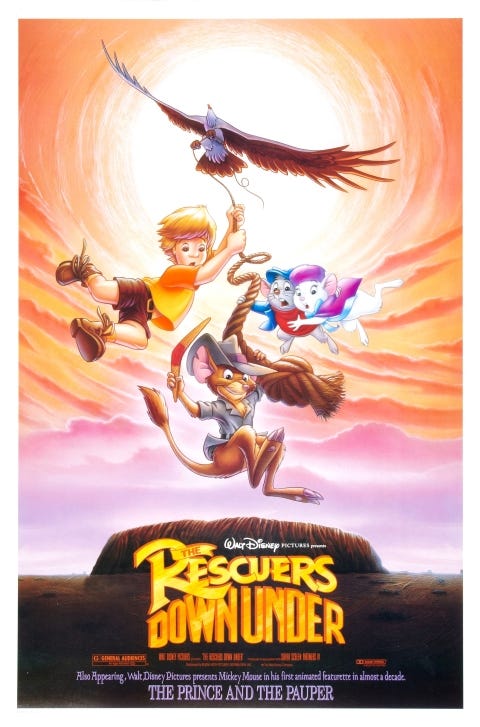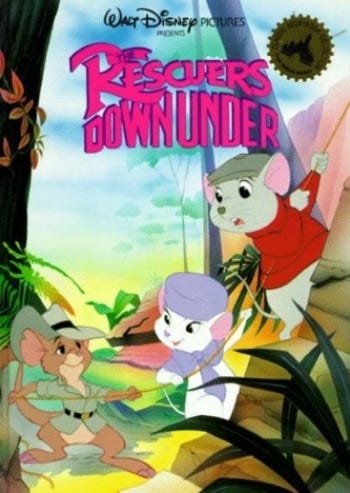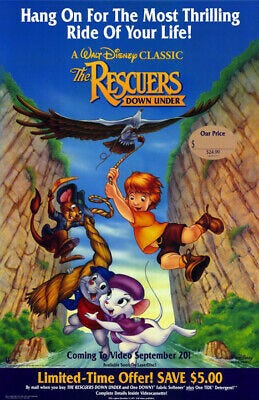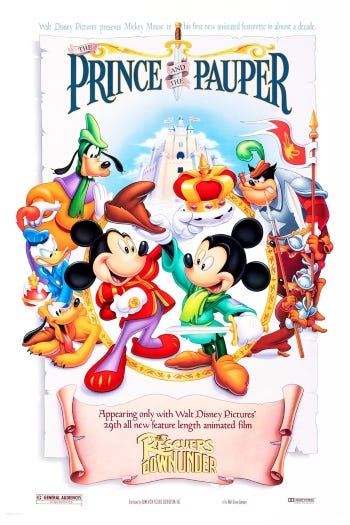Disney Plus-Or-Minus: The Rescuers Down Under
After the triumph of The Little Mermaid in 1989, everyone was eager to see what Walt Disney Animation would do for an encore. Would they take another great leap forward in animated storytelling? Or would they fall back to the so-so output that had dominated theatres for most of the 1970s and ‘80s? The answer turned out to be a little bit of both and it came in the form of a sequel nobody was really clamoring for.
If you were Michael Eisner or Jeffrey Katzenberg, the idea of a sequel to 1977’s The Rescuers made a lot of sense. Disney had never made a sequel to one of their animated films before (unless you count Melody Time which, let’s face it, is a reach) and sequels had become big business in the past decade. The Rescuers had been one of the studio’s few bright spots in an otherwise dismal decade. At the time of its release, it was the highest-grossing animated movie of all time. Plus, it had the advantage of being based on an entire series of books by Margery Sharp following the adventures of Miss Bianca and Bernard. Just about any executive would greenlight a sequel under those circumstances.
Of course, if you’re familiar with Sharp’s books, you already know that none of Bernard and Bianca’s globe-trotting adventures have anything to do with Australia. Instead of returning to the source material (which they’d already taken plenty of liberties with back in 1977), Disney decided to come up with their own story. While ideas were bandied about, the 1980s craze for all things Aussie was nearing its peak thanks to Crocodile Dundee. Disney was extremely interested in climbing aboard this bandwagon so, in addition to releasing Return To Snowy River, they decided to send the Rescue Aid Society to the Outback.
Storyboard artist Joe Ranft was promoted to story supervisor on the project. Ranft had been at Disney since 1980 but he hadn’t ascended the ranks quickly. For years, he spent most of his time working on TV projects that ended up going unproduced. That frustration probably played a big role in Ranft deciding to do a little moonlighting on The Brave Little Toaster. Back at Disney, he contributed to Who Framed Roger Rabbit, Oliver & Company and The Little Mermaid but The Rescuers Down Under was easily his biggest assignment to date.
Ranft wasn’t the only one getting a promotion. Mike Gabriel started at Disney shortly after Ranft. He’d been mentored by Eric Larson, one of the Nine Old Men, and done character animation on The Black Cauldron and The Great Mouse Detective. He’d also been heavily involved with Oliver & Company, designing characters and developing the story. At first, Gabriel wasn’t sure he wanted to direct at all, having seen first-hand how difficult the job was from Oliver director George Scribner. But the opportunity to create a worthy follow-up to The Rescuers proved impossible to turn down.
Gabriel co-directed the film with Hendel Butoy, another CalArts graduate who’d become a supervising animator on The Great Mouse Detective and Oliver & Company. Butoy and Gabriel had ambitious plans for The Rescuers Down Under. To begin with, they opted to get rid of the long-standing tradition of including original songs. The Rescuers hadn’t been a musical but it still managed to squeeze in a few tunes. The sequel would be an epic action-adventure movie with an emphasis on spectacular visuals. You wouldn’t think this would be a particularly risky decision. But the only other animated movie Disney had ever produced without a single song had been The Black Cauldron and…well, we all know how that turned out.
Bob Newhart and Eva Gabor both signed on to reprise their roles from the original (as did Bernard Fox, who voiced the Chairman of the Rescue Aid Society). This would turn out to be Gabor’s final performance before her death in 1995 at the age of 76. Jim Jordan, who had voiced Orville the albatross in the original, died in 1988, just as the film’s cast was being assembled. As a result, the character was rewritten as Orville’s brother, Wilbur. John Candy, who had signed a development deal with Disney after the release of Splash that hadn’t yet borne fruit, agreed to voice the new character.
The production’s biggest casting coup was securing the services of George C. Scott as the villainous poacher, McLeach. Scott’s voice was one of his most distinctive attributes as an actor, so it’s disappointing that he didn’t do more in animation. It’s likely that his involvement in The Rescuers Down Under led to his only other significant contribution to the medium, providing the voice of Smoke in the bizarre anti-drug special Cartoon All-Stars To The Rescue, executive produced by Roy E. Disney. The special was a Roger Rabbit-style mash-up of popular toons ranging from Winnie the Pooh and Huey, Dewey and Louie to the Smurfs, the Muppet Babies and Bugs Bunny and Daffy Duck, all teaming up to encourage kids to just say no.
The plot of The Rescuers Down Under isn’t quite a carbon copy of the original but it certainly doesn’t stray far from the familiar beats of the first movie. Instead of a kidnapped little girl, our rescu-ee is a little boy named Cody (Adam Ryen). Ranft lobbied hard for the child to be Aboriginal, which would have made more sense, but Katzenberg killed that idea and turned Cody into a blonde white kid with a light Australian accent that essentially disappears after the first ten minutes.
In the film’s spectacular opening sequence, Cody rescues a giant golden eagle named Marahute from a poacher’s trap high atop a ridge. He nearly plummets to his death in the attempt but Marahute saves him in return, taking him on a vertiginous flight across the outback. Back on land, Cody encounters McLeach, who demands to know the location of Marahute’s aerie. When the boy refuses to tell, McLeach takes him back to his lair, throwing Cody’s backpack to the crocodiles so any search party will assume he’s dead. Clearly, this looks like a job for the Rescue Aid Society.
The S.O.S. is relayed from Australia to the Rescue Aid Society HQ deep beneath the United Nations in New York. Bernard and Bianca are swiftly dispatched, interrupting a romantic dinner where Bernard unsuccessfully attempts to pop the question. Our heroes charter a flight to Sydney (via JFK) from Wilbur and meet a local kangaroo mouse named Jake (Tristan Rogers) who volunteers to act as their guide in an attempt to put the moves on Bianca.
The rest of the story treads familiar ground for fans of the original. Bianca and Jake enlist the help of local wildlife to track down Cody while Bernard must summon reserves of courage he didn’t know he had to save the day. There are a few added bits of business revolving around Jake’s thwarted romance of Miss Bianca, Bernard’s postponed proposal and Wilbur’s efforts to escape from a hospital run by a half-mad mouse doctor but none of these side plots interfere for long. In the end, The Rescuers Down Under is, as promised, a straight-forward adventure that holds few, if any, narrative surprises.
What helps set the movie apart is its top-shelf animation and the technology employed to produce it. For years, Disney had been experimenting with computers to both cut costs and allow for shots that simply weren’t possible in hand-drawn animation. In 1986, the studio reached an agreement with a relatively new start-up called Pixar to purchase a custom software they’d developed called the Computer Animation Production System, or CAPS. CAPS was a huge leap forward for animation, eliminating the need for individually painted cels and moving the entire production into the digital realm. Disney gave the system a trial run on the title sequence for The Magical World Of Disney and a single shot in The Little Mermaid before going all-in with The Rescuers Down Under.
CAPS worked extremely well, giving the artists a wider palette of colors and techniques that broadened the film’s look and style. The animators also increased their use of computer-generated environments and vehicles, such as McLeach’s post-apocalyptic Bushwacker truck. But as anyone who has ever attempted to use a brand-new computer system can tell you, there are always a few bugs waiting to be ironed out. And with Katzenberg publicly vowing to release a new animated feature every year, running behind schedule was not an option.
As a result, the studio enlisted the help of their newly established Florida division. This off-shoot was originally intended to produce short films and content for TV and video. While they continued in that function, they would take an increasingly large role in feature production, assisting the California mothership in meeting deadlines and eventually running point on their own in-house projects.
The Florida studio also helped to complete the featurette scheduled to be attached to The Rescuers Down Under. The Prince And The Pauper was the first new Mickey Mouse cartoon since Mickey’s Christmas Carol in 1983. Directed by Oliver & Company’s George Scribner and based on the book by Mark Twain, the 25-minute short offers two Mickeys for the price of one, as well as Donald, Goofy, Pluto and the villainous Pete. It’s a charming throwback to pieces like the Mickey And The Beanstalk segment of Fun And Fancy Free.
Both The Rescuers Down Under and The Prince And The Pauper hit their deadline and made it to theatres, as promised, on November 16, 1990. Critics weren’t nearly as enthusiastic about The Rescuers Down Under as they had been over The Little Mermaid but most still reviewed it positively. Even Gene Siskel, who hadn’t been a fan of the 1977 original, admitted that the new film was an improvement and a visual feast. The movie probably wasn’t going to capture the zeitgeist like The Little Mermaid but the filmmakers still could have hoped to have a hit on their hands.
Unfortunately, November 16 also happened to be the same day Home Alone opened in theatres. That movie not only captured the zeitgeist, it went on to become a perennial Christmas favorite. The Rescuers Down Under simply couldn’t compete. It opened in fourth place with a hair under $3.5 million, behind not only Home Alone but Rocky V and Child’s Play 2.
After its dismal opening weekend, Jeffrey Katzenberg made the curious decision to essentially throw in the towel. He slashed the film’s marketing budget and pulled all TV advertising off the airwaves. To the surprise of no one, The Rescuers Down Under sank quickly after that. It ended up limping its way to slightly under $28 million domestically, not quite breaking even. By comparison, Disney’s re-release of The Jungle Book pulled in over $44 million in free money that year.
Despite its reputation as a forgotten film sandwiched between two of the brightest lights of the Disney Renaissance, The Rescuers Down Under remains an entertaining movie for fans and an important one for animation buffs. Granted, just about any movie could have been the first to utilize CAPS and would therefore be a significant milestone for that reason alone. But the fact that this was a sequel allows us to directly compare the stylistic differences between 1977 and 1990. Hendel Butoy and Mike Gabriel not only made a worthy follow-up to The Rescuers, they pushed the envelope of animation further than anyone had in a very long time. That’s a pretty impressive legacy for a movie that most people remember as a misfire.
VERDICT: Disney Plus









